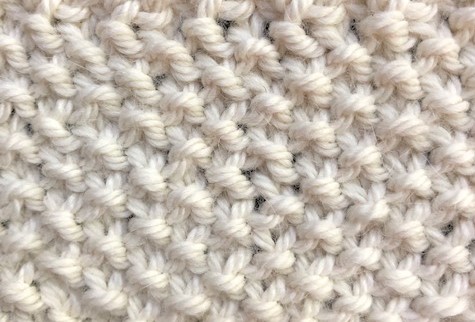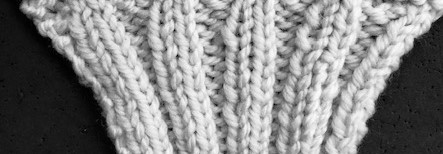Prerequisites
Master Knitting Program and Professional Knitting Certification
The expectations of the Master Knitting Program (MKP) and the Professional Knitting Certification (PKC) exceed those of the knitting industry in many cases. This is the reason a knitter who has attained the designation of Master Knitter or Professional Knitter is respected by those working in the industry.
It is assumed that your work will demonstrate competency in the following categories before beginning work on the MKP or PKC. Any work that does not conform to these standards must be reworked.
- Achieving even tension in stitch patterns
- Accurately measuring knitted fabrics
- Blocking
- Weaving in yarn tails
Photographs follow of unacceptable and acceptable work. If your work does not meet these standards, you should work to improve it before enrolling in these programs. Cast On has several indexes of technical articles available to members which provide help on solving these problems. TKGA also has correspondence courses geared to preparing participants and students for these programs.
Unacceptable
Tension
The following photographs show swatches with UNACCEPTABLE tension.
Stockinette/Reverse Stockinette



Garter and Seed Stitch


Ribbing

Cables

Cast-On and Bind-Off Edges


Measurements
Make sure your work represents the measurements listed in instructions/patterns. It will be impossible to achieve the exact measurements at all times but make sure your work is within 0.25″ of the specified measurements.
Blocking
All swatches should be blocked properly. Wet blocking is recommended. The selvedge stitches should be flat. The sides should be the same length. Textured patterns such as ribbing or cables should not be blocked flat. The following photograph shows a swatch with UNACCEPTABLE blocking. Examples of acceptable work follow.

Weaving in Yarn Tails
All yarn tails should be woven in using a technique appropriate to the stitch pattern. The goal when weaving in yarn tails is that they are not visible on the RS, they stretch with the fabric and do not pucker. The end of the tail should never pull through to the RS. For stockinette stitch, the duplicate stitch is recommended. For items that are seamed, the ends can be placed in the seams. The following photographs show swatches with UNACCEPTABLE tail weaves.


Split, Dropped and Twisted Stitches
Check your work frequently to make sure there are no split, dropped or twisted stitches. The following photograph shows an example of each.

Acceptable Work
Tension, Blocking and Measurements
Keep in mind that perfection in hand knitting is not possible. It is hand knitting, not machine knitting. The following photographs show swatches with acceptable tension which are properly blocked. All swatches were knit with KnitPicks Wool of the Andes Worsted.




Tail Weaves
The following photograph shows recommended methods for weaving in yarn tails. Duplicate stitch is recommended for stockinette stitch. When done properly, it does not distort the fabric, show through to the RS, or pull free. The method shown for ribbing does not impede the stitch pattern’s elasticity or show through to the RS.


